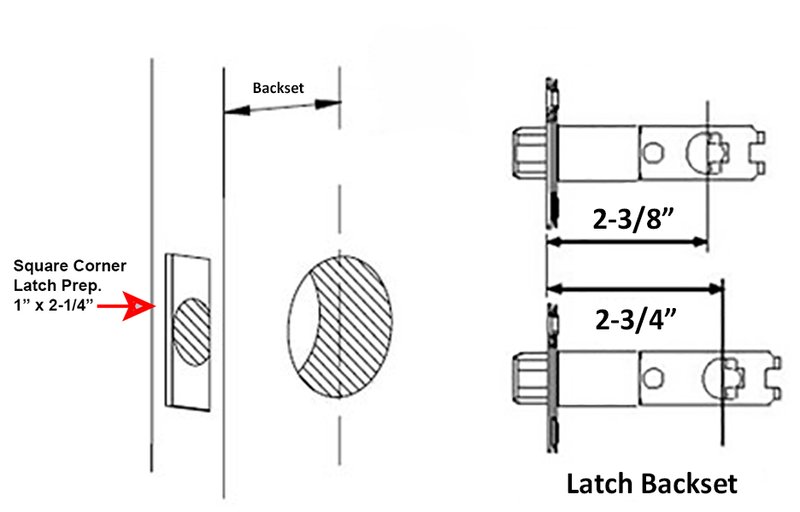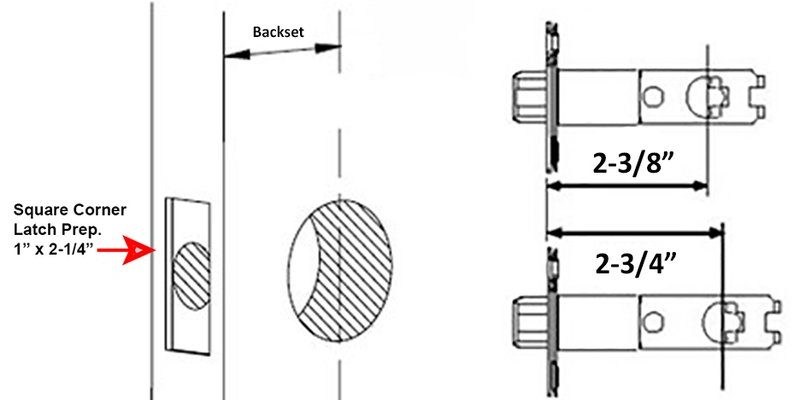
Now, you might be wondering what backset even means. Essentially, it’s the distance from the edge of the door to the center of the latch hole. This measurement can vary depending on the type and brand of your latch, and having the correct backset can save you from unnecessary headaches down the road. In this guide, I’ll walk you through the steps to measure a door latch backset accurately, so you can feel confident when it’s time for that replacement.
What is a Door Latch Backset?
Let’s dive a bit deeper into what backset actually is. The backset is a crucial dimension that determines how far the latch is set back from the edge of the door. It’s usually measured in inches, commonly at distances like 2 3/8″ or 2 3/4.” Knowing this measurement is important because it impacts the alignment of your latch or lock with the strike plate on the door frame. If the backset isn’t right, your door could stick or not close properly.
In practical terms, think of the backset like the legroom you need in a car. Too little, and you’ll feel cramped; too much, and you might be reaching too far. A precise backset means your door operates smoothly and securely, just as you want.
Tools You’ll Need
Before jumping into the measuring process, gather a few essential tools. You won’t need anything fancy, just some common household items:
- Measuring tape: A flexible measuring tape is ideal for this task.
- Pencil: You’ll want to mark your measurements, so have a pencil handy.
- Level: A small level can help ensure everything is straight, especially if you’re installing a new latch later.
With these tools, you’re ready to take on the task. It’s like preparing for a mini adventure: the more prepared you are, the smoother the journey will be.
How to Measure the Backset
Now, let’s get to the measuring part. Here’s a step-by-step approach that makes it easy to get an accurate measurement:
1. Position the Door: Make sure the door is fully open. This gives you clear access to the edge of the door, where you’ll be measuring.
2. Find the Center of the Latch Hole: Look for the latch hole on the edge of the door. This is where the latch bolt enters when you close the door. You’ll want to measure from here to the edge of the door.
3. Measure the Backset: Using your measuring tape, measure from the edge of the door to the center of the latch hole. Make a note of this measurement, and double-check it to ensure accuracy. It’s better to measure twice than to end up with a latch that doesn’t fit.
4. Document Your Findings: Write down your measurements. This will come in handy when you shop for a new latch.
Taking this measurement doesn’t have to be intimidating. Just think of it like checking if your shoes fit—you want to know they’ll be just right before you commit.
Common Backset Sizes
Understanding the common backset sizes can help you choose the right latch. The two most typical sizes are:
- 2 3/8 inches: This is the most common backset for residential doors.
- 2 3/4 inches: Often used for more robust or commercial doors.
If your measurement falls between these two sizes, it’s crucial to choose the one that’s closest. Some latches are adjustable, but it’s always best to go with the size that matches your door.
Adjustable Backset Latches
In recent years, adjustable backset latches have become quite popular. These latches can accommodate both 2 3/8″ and 2 3/4″ backsets, allowing for more flexibility. If you’re unsure about your measurement or if doors might change in the future, an adjustable latch could be a smart investment.
Here’s the thing: while adjustable latches give options, they might not fit as snugly in every situation. If you’re going for a precise aesthetic or security fit, sticking with a specific backset is usually better.
Potential Problems and Solutions
Sometimes, measuring for a backset can lead to complications. You might run into a few common issues, like:
– Inconsistent Measurements: If you’re getting different measurements, make sure your measuring tape is straight and not bending.
– Old Doors: If your door is older, wear and tear might have changed the backset. Always measure again if you replace an old latch.
– Misalignment: If the latch doesn’t align with the strike plate after installation, you may need to adjust the backset or reposition the latch hole.
Here’s a tip—if your door is older, consider consulting a professional if you’re concerned about inaccuracies in your measurements. It’s better to seek help than to struggle with a latch that won’t fit.
Final Thoughts on Measuring Backset
Measuring a door latch backset doesn’t have to be a daunting task. With the right tools and a clear understanding of the process, you can confidently take on this DIY project. Remember, accurate measurements are key. Whether it’s for a new latch or replacing an old one, each step you take is about ensuring your door works smoothly and securely.
So next time you find yourself needing to replace a latch, think of it as a simple puzzle. With a little patience and the right measurements, you’ll have everything fitting just right. Happy DIYing!
